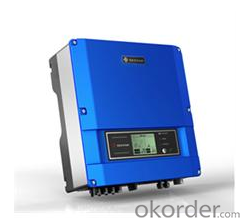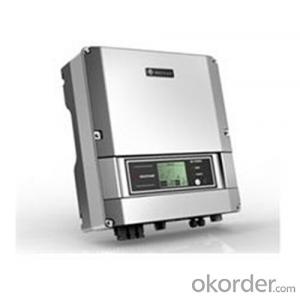Solar Inverter in Pakistan - On Grid Solar Inverter GS4600-SS
- Loading Port:
- Shanghai
- Payment Terms:
- TT OR LC
- Min Order Qty:
- 10 unit
- Supply Capability:
- 100 unit/month
OKorder Service Pledge
OKorder Financial Service
You Might Also Like
GW4600-SS
GW4600-SS photovoltaic inverter is suitable for home rooftop photovoltaic system, designed under modern industrial concept. There are three colors for option with fashionable appearance. The maximum output power of this model can reach 5100W. It is not only the largest one among GoodWe single-phase inverters, but also the model with the maximum power using single-tube design. Besides, it maintains extremely higher conversion efficiency, uses natural heat dissipation and has an extremely wide range of input voltage and input current. It holds a safe lead among the same level of products.
| DC Input Data | Max.PV-generator power[W] | 5400 |
| Max.DC voltage[V] | 580 | |
| MPPT voltage range[V] | 125~450 | |
| Turn on DC voltage[V] | 125 | |
Max.DC work current[A] | 20 | |
| Number of inputs/MPP trackers | 3/1 | |
| DC connection | MC IV Connector | |
| Self-energy consumption[W] | <5< td=""> | |
| AC Output Data | Nominal AC power[W] | 4600 |
| Max.AC power[w] | 5100 | |
| Max.output current[A] | 25 | |
| Nominal output voltage range | According to VDE0126-1-1/AI, RD1663, ENEL, G83,G59,SAA | |
| AC grid frequency | According to VDE0126-1-1/AI, RD1663, ENEL, G83,G59,SAA | |
| THDi | 〈1% | |
| Power factor | ~1 (Norminal power) | |
| AC connection | Single phase | |
| Efficiency | Max.efficiency | 97.8% |
| European efficiency | 97.4% | |
| MPPT adaptation efficiency | >99.5% | |
| Safty Equipment | Leakage current monitoring unit | Integrated |
| DC disconnector switch | Optional | |
| Islanding protection | AFD | |
| Grid monitoring | According to VDE 0126-1-1/AI,AS4777.1/2/3, RD1663, ENEL,G83,G59-2 | |
| Normative Reference | EMC compliance | EN 61000-6-1,EN 61000-6-2, EN 61000-6-3,EN 61000-6-4 |
| Safety compliance | According to IEC 62109-1,AS3100 | |
| General Data | Dimensions(W*H*D) [mm] | 390*417*142 |
| Net weight [kg] | 18 | |
| Housing | For outdoor and indoor | |
| Mounting information | Wall mounting | |
| Operating temperature range | -20~60℃(up 45℃ derating) | |
| Relative humidity | 0 ~ 95% | |
| Site altitude[m] | 2000 | |
| IP proection class | IP65 | |
| Topology | Transformerless | |
| Cooling | Nature convection | |
| Noise level[dB] | 〈25 | |
| Display | 4"LCD | |
| Communication | USB2.0;RS485(Wireless/Bluetooth optional) | |
| Standard warranty[years] | 5/10(optional) |
- Q: Can a solar inverter be used with different types of backup power sources?
- Yes, a solar inverter can be used with different types of backup power sources. Solar inverters are designed to convert the DC power generated by solar panels into AC power that can be used to power household appliances and devices. They can be connected to various backup power sources like batteries, generators, or the grid to provide uninterrupted power supply during periods of low sunlight or power outages.
- Q: How is the efficiency of a solar inverter measured?
- The efficiency of a solar inverter is typically measured by dividing the output power of the inverter by the input power, and then multiplying the result by 100 to get a percentage value.
- Q: What are the potential risks of overheating a solar inverter?
- The potential risks of overheating a solar inverter include reduced efficiency, decreased lifespan, and potential damage to the internal components. It can also lead to unexpected shutdowns or malfunctions, resulting in a decrease in solar energy production. Additionally, overheating can pose a fire hazard, especially if proper cooling mechanisms or ventilation are not in place. Regular monitoring and maintenance are crucial to prevent these risks and ensure optimal performance of the solar inverter.
- Q: What is the difference between a transformerless inverter and a transformer-based inverter?
- A transformerless inverter and a transformer-based inverter differ primarily in their design and functionality. A transformerless inverter, as the name suggests, does not incorporate a transformer in its circuitry. It uses advanced electronic components and techniques to convert direct current (DC) into alternating current (AC). This makes it more compact, lightweight, and cost-effective compared to transformer-based inverters. However, it may have limitations in terms of voltage isolation and grounding. On the other hand, a transformer-based inverter includes a transformer in its design. This allows for voltage transformation, isolation, and improved grounding capabilities. It provides better protection against electrical surges, noise, and voltage fluctuations. However, transformers add weight, increase size, and are more expensive compared to transformerless inverters. The choice between a transformerless and a transformer-based inverter depends on the specific requirements of the application. Transformerless inverters are commonly used in residential solar power systems, while transformer-based inverters are often preferred for industrial or commercial applications where higher power levels and enhanced protective features are necessary.
- Q: What is the maximum AC voltage that a solar inverter can provide?
- The maximum AC voltage that a solar inverter can provide typically depends on the specific model and its specifications. However, most residential and commercial solar inverters provide a maximum AC voltage output of around 240 volts or 480 volts, depending on the electrical grid requirements and system configurations.
- Q: How does a solar inverter handle voltage and frequency variations caused by grid disturbances?
- A solar inverter is designed to handle voltage and frequency variations caused by grid disturbances by regulating and stabilizing the incoming AC power from the grid. It constantly monitors the voltage and frequency levels of the grid and adjusts its internal components accordingly to ensure that the power being generated by the solar panels is synchronized with the grid. In cases of voltage or frequency deviations, the inverter employs advanced control algorithms to rectify the imbalances and maintain a steady flow of power to the grid. This helps to protect the electrical appliances and equipment connected to the grid from potential damage and ensures the stability and reliability of the overall power system.
- Q: Can a solar inverter provide power during a blackout?
- No, a solar inverter cannot provide power during a blackout.
- Q: Can a solar inverter be connected to a generator?
- Yes, a solar inverter can be connected to a generator. This can be useful in situations where solar power is not sufficient or unavailable, allowing the generator to supplement the power supply.
- Q: Can a solar inverter be used with a solar-powered refrigerator?
- Yes, a solar inverter can be used with a solar-powered refrigerator. The solar inverter is responsible for converting the direct current (DC) electricity generated by the solar panels into alternating current (AC) electricity, which is required to power the refrigerator. By using a solar inverter, the solar-powered refrigerator can operate efficiently and effectively by utilizing the solar energy collected from the panels.
- Q: What is the role of a power factor controller in a solar inverter?
- The role of a power factor controller in a solar inverter is to regulate and maintain the power factor of the inverter's output. It ensures that the inverter's output power is in phase with the grid voltage, maximizing the efficiency of power transfer and reducing reactive power losses. By improving the power factor, the power factor controller helps to ensure stable and reliable operation of the solar inverter while meeting grid requirements and minimizing energy wastage.
Send your message to us
Solar Inverter in Pakistan - On Grid Solar Inverter GS4600-SS
- Loading Port:
- Shanghai
- Payment Terms:
- TT OR LC
- Min Order Qty:
- 10 unit
- Supply Capability:
- 100 unit/month
OKorder Service Pledge
OKorder Financial Service
Similar products
Hot products
Hot Searches
Related keywords



























